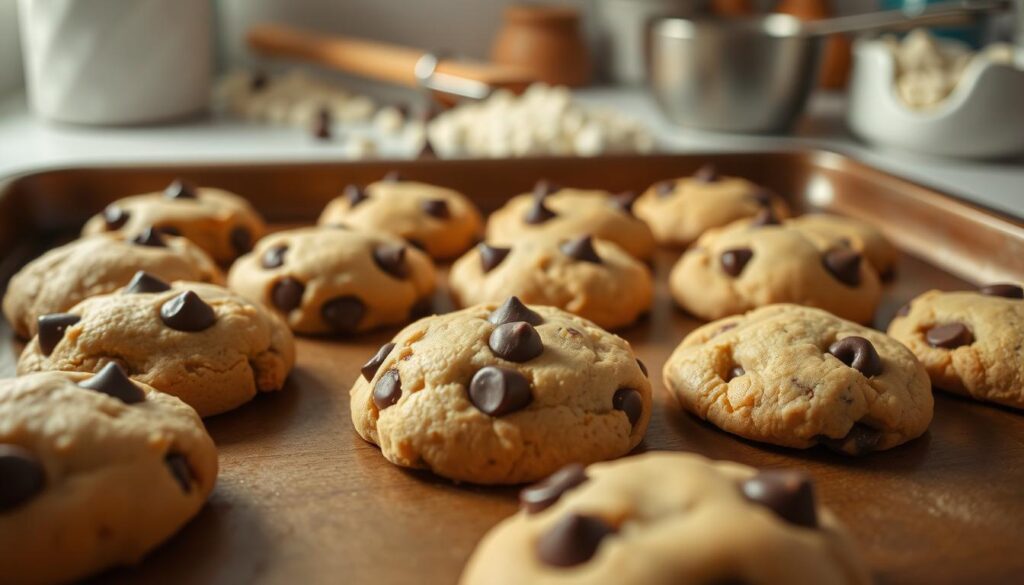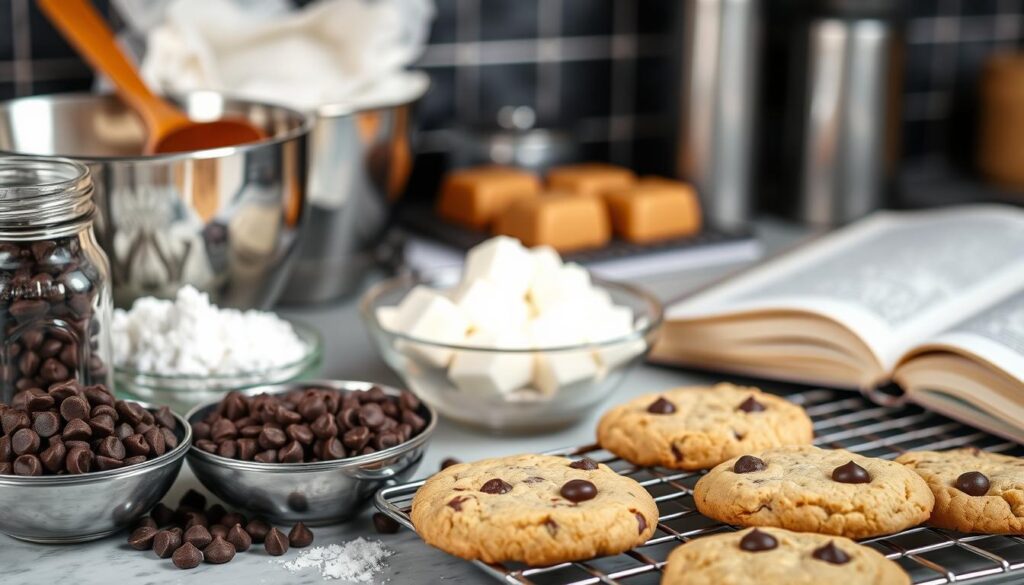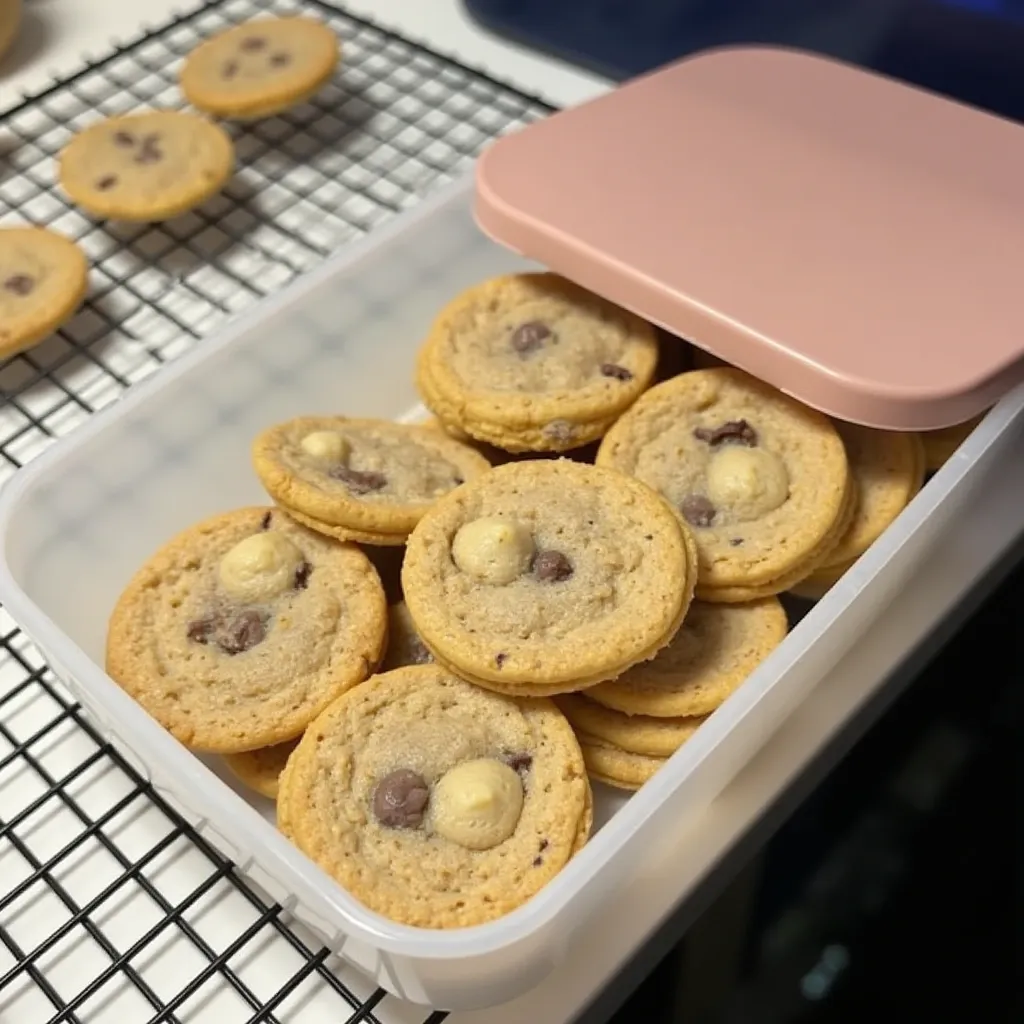Ever wondered why your Nestle chocolate chip cookies turn out flat? You’re not alone. Many bakers struggle with this issue, even with the simple Nestle recipe. Getting that perfect cookie—crisp edges and chewy center—isn’t always easy.
We’ll look at why your cookies might spread too much. From the right butter temperature to accurate flour measurement, we’ve got tips. Ready to make those perfect Nestle chocolate chip cookies?

Understanding the Basics of Chocolate Chip Cookies
Creating perfect chocolate chip cookies starts with knowing the cookie baking fundamentals. Each ingredient adds something special to the taste and texture. Flour is the main part of the cookie, giving it structure.
Too much flour makes cookies like biscuits. They don’t spread well and can be dry. Finding the right mix of flour and butter is key for the perfect cookie.
The basic chocolate chip cookie recipe has flour, sugar, butter, eggs, and chocolate chips. Butter makes the cookies tender and tasty. Sugar adds sweetness and helps them brown.
Brown sugar makes them chewier. Eggs help hold everything together and add moisture. Using room temperature butter is important. Too soft or melted butter can make cookies flat. Not enough flour can make them crispy.

Mixing techniques are also important. Overmixing can stop cookies from rising right. Mix well but don’t overdo it, especially when creaming sugar and butter.
Trying different ingredients can change the cookie’s taste. Adjusting a Nestle chocolate chip cookie recipe to your liking can make your dream cookie. Whether you like them soft, chewy, or crispy, you can get it right.
Why Do My Nestle Chocolate Chip Cookies Go Flat?
Your Nestle cookie baking might not always give you the thick, chewy cookies you want. Knowing the reasons for flat chocolate chip cookies can help a lot. Two big mistakes are using too much sugar and not chilling the dough.
Too much sugar changes the flavor and makes cookies spread. Chilling the dough helps keep them from spreading too much. This keeps them looking better.
Butter’s temperature is key for the right dough. If it’s too soft or almost melted, cookies can get greasy and flat. Mixing granulated and brown sugar right can make cookies chewier. This improves flavor and stops them from getting flat.
Other common baking mistakes include unevenly heated baking sheets and old leavening agents. Bad sheets can bake cookies unevenly. Fresh leavening agents are crucial for cookies to rise right. Measuring ingredients, especially flour, accurately helps too. Too much flour makes cookies more like biscuits than chewy treats.

The Importance of Butter Temperature
Knowing the right butter temperature is key for perfect chocolate chip cookies. Softened butter is creamy but still has structure. Melted butter, on the other hand, makes cookies spread too much.
Softened butter helps create air pockets. This air helps cookies rise during baking. So, using the right butter temperature is crucial to avoid flat cookies.
Softened vs. Melted Butter
Softened butter is about 65 degrees Fahrenheit. It mixes well with sugar, creating air pockets. Melted butter, however, makes dough dense and cookies spread too much.
If your cookies are flat, check your butter. Margarine or coconut oil can change the cookie’s texture. Always use softened butter for the best results.
How to Properly Soften Butter
To soften butter, take it out of the fridge 30 minutes before baking. Check its softness by pressing it gently. It should yield but not be mushy.
If you’re short on time, cut the butter into smaller pieces. This helps it soften faster. Avoid melting butter, as it can’t hold air well. The right butter temperature is important for great cookies.
The Role of Flour in Cookie Texture
Flour is key in making cookies the right way. It’s important to measure flour correctly to get the right cookie texture. This ensures cookies keep their shape and texture while baking.
Measuring Flour Accurately
Measuring flour right is very important. Using a kitchen scale is the best way to do this. Scooping flour from the bag can pack it too much, making cookies dry.
Getting flour measurement right helps make cookies that are just right. This makes every cookie a delight to eat.
Effects of Too Little or Too Much Flour
Not enough flour makes cookies flat and greasy. Too much flour makes them dry and dense. Finding the right balance is key for perfect cookies.
Knowing how flour affects cookies is crucial. It helps make cookies that are just right, with the perfect texture.
Leavening Agents and Their Freshness
Baking delicious chocolate chip cookies needs understanding leavening agents. Agents like baking soda and baking powder help cookies rise. Using old leavening agents makes cookies flat and dense.
Why Expired Baking Soda Affects Cookies
Expired baking soda changes how cookies bake. Fresh baking soda creates air pockets for lift. To check if baking soda is fresh, mix a bit with vinegar. If it fizzes, it’s good; if not, replace it.
Checking the Freshness of Baking Powder
Baking powder must be fresh too. Old baking powder doesn’t leaven cookies well. To test, mix a teaspoon with hot water. A big fizz means it’s fresh; a small fizz or none means it’s time to replace it.
Impact of Sugar Types on Cookie Spread
Sugar types in baking are key to cookie texture and spread. Knowing about different sugars helps you get the right cookie. White sugar makes cookies spread wide, while brown sugar adds moisture and density, making them thicker.
The mix of these sugars greatly affects cookie look and taste.
Difference Between White and Brown Sugar
Granulated sugar melts in baking, making cookies flat. But, brown sugar, with molasses, keeps moisture in. This makes cookies thicker and chewier.
Changing sugar ratios can make your cookies just right for you.
The Effect of Sugar Ratios on Cookie Texture
Sugar mix in your dough affects texture and look. Less white sugar and more brown sugar means denser, tastier cookies. Tinkering with sugar ratios changes taste and texture.
The Influence of Temperature and Humidity
Success in baking can depend on things like temperature and humidity. These factors are key in managing cookie dough. When it’s humid, dough can soak up moisture, making cookies softer. This is something every baker should think about when they’re baking.
How Weather Affects Baking
Weather can change how cookies turn out. High humidity can make dough spread too much. It’s important to adjust recipes or techniques for humid weather.
In warm, humid weather, use less liquid. This helps keep the dough from getting too soft. Also, use methods to keep the dough’s consistency right for baking.
Keeping Dough Cold in Warm Weather
Managing cookie dough is crucial in warm weather. Using cold dough helps cookies stay thicker. Chill your dough for at least 30 minutes before baking.
Working with chilled dough helps control temperature and humidity effects. Try to handle dough quickly or work in a cooler place. This keeps your cookies just right.
Chilling Dough for Better Results
Chilling cookie dough makes your baked treats better. It makes the dough stronger, so cookies spread less. This means your cookies will be thicker, chewier, and taste better.
This trick is especially good in warm places. Heat can make dough spread too much, making cookies flat. Adding this step to your baking routine can really improve your results.
Benefits of Chilling Cookie Dough
Chilling dough lets flavors mix well. It makes the dough taste richer. It also keeps the fat cold, so cookies don’t spread too much.
This makes cookies chewy inside and crispy outside. For cookies like Nestle Toll House chocolate chip, chilling is key for the right texture.
How Long to Chill for Optimal Results
Chill your dough for at least 30 minutes for best results. Even 15 minutes can help if you’re short on time. But chilling for hours or overnight is even better.
Freezing shaped dough balls is a great way to bake later. It keeps quality high. Proper chilling times can make your baking much better, every time.
FAQ
Why do my Nestle chocolate chip cookies come out flat every time?
Flat cookies often come from wrong ingredient ratios. Check your flour and butter temperature. Make sure your butter is soft, not melted.
How important is the temperature of the butter in my cookie recipe?
Butter temperature is key for cookie texture. Softened butter is best for creaming with sugar. Melted butter can make cookies spread too much.
What is the best way to measure flour accurately?
Use a kitchen scale for the most accurate flour measurement. If measuring by volume, spoon flour into the cup and level it off. Avoid packing it down to prevent dry cookies.
Can the type of sugar affect my cookie results?
Yes, sugar type changes cookie texture and spread. White sugar spreads more, while brown sugar adds moisture and flavor. Finding the right balance is important.
Why might my leavening agents be causing flat cookies?
Old baking soda or powder can stop cookies from rising. Always check their freshness before baking.
How does weather impact my cookie baking?
High humidity can make dough absorb moisture, leading to soft cookies. In warm weather, keep dough cold to prevent spreading.
How long should I chill cookie dough before baking?
Chilling dough for at least 30 minutes improves structure and reduces spreading. This is especially helpful in warm climates.
What are the signs that my baking powder is stale?
To check baking powder freshness, mix a small amount with vinegar. If it bubbles well, it’s good. If not, it’s time to replace it.
How can I prevent my cookies from spreading too much while baking?
To stop cookies from spreading too much, check your ingredient ratios. Chill the dough and use less white sugar, which spreads more.

